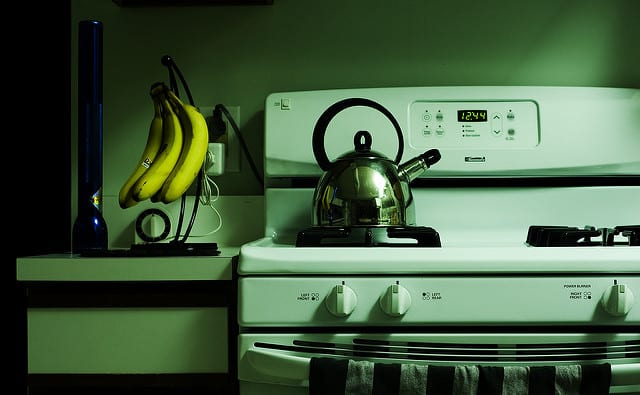At Postconsumers, we have an admitted love – and we mean love – of food. In fact, we have an entire section of the site devoted to both food-related consumerism and eco-friendly food. Our love of food means that we also have a love of cooking food and of being in our kitchen. Ok, admittedly, that’s not all of us. But it does represent a significant portion of our team. Because we think that environmentalism and consumerism are so intricately linked in the current era, we have a deep consciousness about being as “green” as we can be in the kitchen. In honor of Earth Day month, we’ve put together some of our most effective tips for reducing your carbon footprint in your kitchen.
Rearrange! Refrigerators Go Into the Shade!
We know that changing where your major appliances are in your kitchen can be a huge deal. But if you have the flexibility (or if you are undergoing a kitchen renovation in the near future), refrigerators and freezers should never be in a regularly sunny spot. The warmer the environment around the refrigerator or freezer is, the harder it needs to work in order to stay cold. Put your cool appliances in places that are already cold whenever possible.
Microwave Ovens Aren’t All Bad
We certainly do not want to get into a debate with you over microwave ovens. We’re in agreement that there’s something scary about microwaves just running through your food and your kitchen – and there’s some degree of research to back that up. There’s also research that goes in the other direction, though. What we do know for sure, however, is that microwave cooking uses less energy than stovetop or oven cooking does. So if your concern is being as energy efficient as possible, full or partial cooking of your meal in a microwave is a pro for you, not a con.
Not All Appliances Need to Be Plugged In at All Times
Be honest, do you use your industrial-style mixer and bowl daily? If you do, then we want to be coming to your house to eat more often! Electric appliances draw energy from the outlet any time that they are plugged in whether they are actively turned on or not. That means that even if you only use an appliance once or twice a month, you’re using energy to power it the entire month. Unplug any appliances that you don’t use regularly to reduce energy burn (and bills). You may even want to consider packing some of them away to reduce kitchen counter clutter.
Food Shop More Frequently
Food waste in America and the carbon footprint that comes with it is out of control. There’s no debate about that at all. What causes this food waste? There are so many factors that it would require an article all of its own. However, one undeniable contributor is the way that Americans shop for food. Rather than buying what is needed for each day’s meal as many other countries do, Americans take weekly or sometimes even monthly trips to gigantic super stores and buy food in bulk or large quantities. We completely understand that the contemporary lifestyle may not allow you to buy food on a daily as-needed basis, but the less often you buy food and the smaller the quantities that you buy, the less food that you’ll waste and the more you’ll reduce your carbon footprint in the kitchen, the dining room and anywhere that food is involved.
Pro Tip: If you do find yourself regularly having excess food, don’t hoard it! Donate it before it goes bad.
Invest in a Tap Water Filter
How do you get your clean drinking water? If you’re buying it in bottles, then you’re absorbing a carbon footprint even if you’re ultimately recycling all of the bottles. Save up some money and invest in a high-end (or even low-end, they’re both relatively pricey) tap filter. You’ll not only get better drinking water, but the water you’re using for washing dishes or boiling water will be better. And you’ll reduce the carbon footprint of all of those plastic bottles.
Turn The Kitchen Into a Garden
You might be surprised how easy it is to grow some food indoors year-round. Clear out the spaces in your corners, around your windows (if you have them) and even on the countertop. Not only will you be able to eat the food that you grow, but your kitchen will look and feel so much more inviting. Not a green thumb? Consider a hydroponics kit. But if you’re ready to get dirty in the kitchen, we have a great list of vegetables, herbs and even a fruit that are super-easy to grow indoors.
Upgrade to Copper Cookware
Yes, we know. We’re suggesting that you purchase something and nobody likes that. But there are legitimate eco-friendly benefits to cooking in copper. Aluminum cookware takes more time to heat up than does copper, which means that you use more energy to heat and cook your food. There’s a reason that professional chefs tend to use copper cookware. You’ll also want to get over your love of non-stick cookware. It may make life easier, but it involves lots of non-earth-friendly toxins.
Aluminum Foil: It Can Be Used More Than Once
This “famous” tip is fast and easy! Save and reuse aluminum foil – it’s tough enough for it! And if you are getting rid of aluminum foil, remember that anything aluminum – even foil –can be recycled.
Now, get out and get cooking!
Did we miss a way that your kitchen could be more eco-friendly? Tell us about it on the social media channels below.
Facebook | Twitter | Instagram | Tumblr | Pinterest | Google+ | Medium
Photo Credit: Jake Gagne via Flickr





